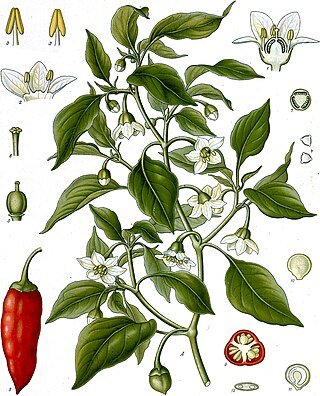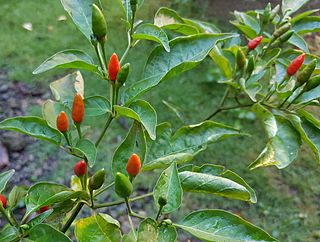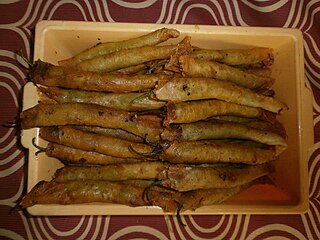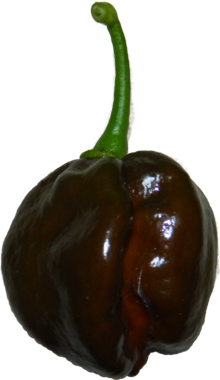
The Scoville scale is a measurement of pungency of chili peppers and other substances, recorded in Scoville heat units (SHU). It is based on the concentration of capsaicinoids, among which capsaicin is the predominant component.

Chili peppers, also spelled chile or chilli, are varieties of the berry-fruit of plants from the genus Capsicum, which are members of the nightshade family Solanaceae, cultivated for their pungency. Chili peppers are widely used in many cuisines as a spice to add "heat" to dishes. Capsaicin and related compounds known as capsaicinoids are the substances that give chili peppers their intensity when ingested or applied topically. Chili peppers exhibit a range of heat and flavors. This diversity is the reason behind the availability of different types of paprika and chili powder, each offering its own taste and heat level.

Scotch bonnet is a variety of chili pepper named for its supposed resemblance to a Scottish tam o' shanter bonnet. It is ubiquitous in West Africa and the Caribbean.

A chipotle, or chilpotle, is a smoke-dried ripe jalapeño chili pepper used for seasoning. It is a chili used primarily in Mexican and Mexican-inspired cuisines, such as Tex-Mex and Southwestern United States dishes. It comes in different forms, such as chipotles en adobo.

Hot sauce is a type of condiment, seasoning, or salsa made from chili peppers and other ingredients. Many commercial varieties of mass-produced hot sauce exist.

Capsicum annuum, commonly known as paprika, chili pepper, red pepper, sweet pepper, jalapeño, cayenne, or bell pepper, is a fruiting plant from the family Solanaceae (nightshades), within the genus Capsicum which is native to the northern regions of South America and to southwestern North America. The plant produces berries of many colors including red, green, and yellow, often with pungent taste. It is also one of the oldest cultivated crops, with domestication dating back to around 6,000 years ago in regions of Mexico. The genus Capsicum has over 30 species but Capsicum annuum is the primary species in its genus, as it has been widely cultivated for human consumption for a substantial amount of time and has spread across the world. This species has many uses in culinary applications, medicine, self defense, and can even be ornamental.

Capsicum chinense, commonly known as a "habanero-type pepper", is a species of chili pepper native to the Americas. C. chinense varieties are well known for their unique flavors and, in many cases, exceptional heat. The hottest peppers in the world are members of this species, with a Scoville Heat Unit score of 2.69 million measured in the C. chinense cultivar, Pepper X in 2023.

The Red Savina pepper is a cultivar of the habanero chili, which has been selectively bred to produce spicier, heavier, and larger fruit, ultimately more potent than its derivative.

The poblano is a mild chili pepper originating in Puebla, Mexico. Dried, it is called ancho or chile ancho, from the Spanish word ancho (wide). Stuffed fresh and roasted, it is popular in chiles rellenos poblanos.
Búfalo is a brand of hot sauce and other condiments produced by Herdez Group of Lomas de Chapultepec, Mexico. Búfalo sauce has been produced since 1933. The company produces Búfalo and Tampico sauces, salsas, and other condiments. In the United States, English-labeled bottles are distributed by MegaMex Foods, a joint venture between Herdez and Hormel Foods.

The Naga Morich is a chili pepper originally grown primarily in Bangladesh and Northeast India. It is also one of the hottest known chilli peppers and measures 800,000 SHU on Scoville scale. Morich is the word for chilli pepper in Bengali, with similar words in Assamese:, Nepali, Hindi and the languages of Nagaland and Manipur. "Naga Mircha" is registered under the Geographical Indications (GI) of Nagaland by Government of India.

Siling labuyo is a small chili pepper cultivar that developed in the Philippines after the Columbian Exchange. It belongs to the species Capsicum frutescens and is characterized by triangular fruits that grow pointing upwards. The fruits and leaves are used in traditional Philippine cuisine. The fruit is pungent, ranking at 80,000 to 100,000 heat units in the Scoville Scale.

The Fatalii is a cultivar of the chilli pepper Capsicum chinense developed in southern or central Africa from chilies introduced from the Americas. It is described as having a fruity, citrus flavor with a searing heat comparable to the habanero, to which it is related and from which it may have derived.

The Infinity Chili pepper is a chili pepper hybrid of the Capsicum chinense species created in England by chili breeder Nicholas Woods of Fire Foods, Grantham, Lincolnshire. For two weeks in February 2011, the Infinity Chili held the Guinness World Record title for the world's hottest chili with a Scoville scale rating of 1,067,286 Scoville Heat Units (SHU). On March 1, 2011, it was displaced by the Trinidad Scorpion Butch T pepper, which registered 1,463,700 SHU.

Oaxacan cuisine is a regional cuisine of Mexico, centered on the city of Oaxaca, the capital of the eponymous state located in southern Mexico. Oaxaca is one of the country's major gastronomic, historical, and gastro-historical centers whose cuisine is known internationally. Like the rest of Mexican cuisine, Oaxacan food is based on staples such as corn, beans, and chile peppers, but there is a great variety of other ingredients and food preparations due to the influence of the state's varied geography and indigenous cultures. Corn and many beans were first cultivated in Oaxaca. Well-known features of the cuisine include ingredients such as chocolate, Oaxaca cheese, mezcal, and grasshoppers (chapulines), with dishes such as tlayudas, Oaxacan-style tamales, and seven notable varieties of mole sauce. The cuisine has been praised and promoted by food experts such as Diana Kennedy and Rick Bayless and is part of the state's appeal for tourists.

Pique is a traditional hot sauce from Puerto Rico that is typically made with a variety of chili peppers, garlic, and spices. It is often made by fermenting the ingredients, which can give it a unique flavor profile and a more complex taste. Some variations may include ingredients such as cilantro, oregano, or onions. Pique is commonly used as a condiment for a variety of traditional Puerto Rican dishes such as rice, beans, and meat dishes. It can also be used as a marinade for meats or as a dip for tostones or other fried foods. Pique is a staple condiment in Puerto Rico and is often homemade, but can also be found in grocery stores.

Bird's eye chili or Thai chili is a chili pepper variety from the species Capsicum annuum that is native to Mexico. Cultivated across Southeast Asia, it is used extensively in many Asian cuisines. It may be mistaken for a similar-looking chili derived from the species Capsicum frutescens, the cultivar siling labuyo. Capsicum frutescens fruits are generally smaller and characteristically point upwards. In the Marianas and Guam these are often called boonie peppers or Doni Sali, which can be term for regional wild varieties. The variation between different varieties can be significant for regional dishes or visuals, such as the Thai ornamental varieties.

The habanero is a hot variety of chili. Unripe habaneros are green, and they color as they mature. The most common color variants are orange and red, but the fruit may also be white, brown, yellow, green, or purple. Typically, a ripe habanero is 2–6 centimetres long. Habanero chilis are very hot, rated 100,000–350,000 on the Scoville scale. The habanero heat, flavor, and floral aroma make it a common ingredient in hot sauces and other spicy foods.

Dinamita is a deep-fried Filipino snack consisting of stuffed siling haba wrapped in a thin egg crêpe. The stuffing is usually giniling, cheese, or a combination of both but it can also be adapted to use a wide variety of ingredients, including tocino, ham, bacon, tuna, and shredded chicken. Dinamita is also known as dynamite lumpia, among other names. It is a type of lumpia and it is commonly eaten as an appetizer or as a companion to beer.

Amongst growers in the US, the UK, and Australia, there has been a competition since the 1990s to grow the hottest chili pepper. Chili pepper species and cultivars registering over 1,000,000 Scoville Heat units (SHU) are called "super-hots". Past Guinness World Record holders include the ghost pepper, Infinity chili, Trinidad Moruga scorpion, Naga Viper pepper, Trinidad Scorpion Butch T, and Carolina Reaper. The current record holder, declared in 2023, is Pepper X, at more than 2.69 million SHU.



















